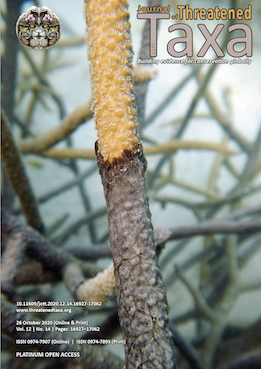Cirsium wallichii DC. (Asteraceae): a key nectar source of butterflies
Main Article Content
Abstract
Abstract: Butterfly diversity and abundance depend on the diversity of foraging resources and nectar characteristics. Several wild plants of the family Asteraceae often considered as weeds, are important nectar sources for butterflies. The present communication reports Cirsium wallichii as a key nectar source for a large number of butterfly species during the summer season in Benog Wildlife Sanctuary, Mussoorie, western Himalaya. Of the total recorded species of butterflies (62), a maximum species (22) belongs to the Nymphalidae family followed by Hesperiidae (13), and Lycaenidae (11) that visits C. wallichii. Therefore, it is suggested that Cirsium wallichii has an important role in sustaining butterfly diversity.
Keywords: Mussoorie, Lepidoptera, .
Article Details
Authors own the copyright to the articles published in JoTT. This is indicated explicitly in each publication. The authors grant permission to the publisher Wildlife Information Liaison Development (WILD) Society to publish the article in the Journal of Threatened Taxa. The authors recognize WILD as the original publisher, and to sell hard copies of the Journal and article to any buyer. JoTT is registered under the Creative Commons Attribution 4.0 International License (CC BY), which allows authors to retain copyright ownership. Under this license the authors allow anyone to download, cite, use the data, modify, reprint, copy and distribute provided the authors and source of publication are credited through appropriate citations (e.g., Son et al. (2016). Bats (Mammalia: Chiroptera) of the southeastern Truong Son Mountains, Quang Ngai Province, Vietnam. Journal of Threatened Taxa 8(7): 8953–8969. https://doi.org/10.11609/jott.2785.8.7.8953-8969). Users of the data do not require specific permission from the authors or the publisher.
References
Baker, H.G. & I. Baker (1983). Floral nectar sugar constituents in relation to pollinator type, pp. 117–141. In: Jones, C.E. & R.J. Little (eds.). Handbook of Experimental Pollination Biology. Scientific and Academic Editions, New York, 558pp.
Champion, H.G. & S.K. Seth (1968). A Revised Survey of Forest Types of India. Govt. of India Press, Delhi, 404pp.
Courtney, S.P. (1986). The ecology of pierid butterflies: dynamics and interactions. Advances in Ecological Research 15: 51–131.
Evans, W.H. (1932). Identification of Indian Butterflies 2nd edition. Bombay Natural History Society, Bombay, 464pp.
Kapkoti, B., R.K. Joshi & R.S. Rawal (2016). Thistle (Cirsium verutum): An important forage for pollinators in Kumaun, West Himalaya. National Academy Science Letters 39(5): 395–399. https://doi.org/10.1007/s40009-016-0501-x DOI: https://doi.org/10.1007/s40009-016-0501-x
Kehimkar, I. (2016). Butterflies of India. Bombay Natural History Society, Mumbai, 528pp.
Kitahara, M., M. Yumoto & T. Kobayashi (2008). Relationship of butterfly diversity with nectar plant species richness in and around the Aokigahara primary woodland of Mount Fuji, Central Japan. Biodiversity and Conservation 17(11): 2713–2734. https://doi.org/10.1007/s10531-007-9265-4 DOI: https://doi.org/10.1007/s10531-007-9265-4
Kumar, A., M. Mitra, G. Singh & G.S. Rawat (2012). An inventory of the flora of Binog Wildlife Sanctuary, Mussoorie, Garhwal Himalaya. Indian Journal of Fundamental and Applied Life Sciences 2(1): 281–299.
Kunte, K. (2000). India – A Lifescape: Butterflies of Peninsular India. Universities Press, Hyderabad, 254pp.
Mabberley, J.D. (2008). Mabberley’s Plant Book: A Portable Dictionary of Plants, their Classification and Uses 3rd edition. Cambridge University Press, UK, 1102pp.
Mukherjee, S., S. Banerjee, P. Basu, G. Saha & G. Aditya (2015). Lantana camara and butterfly abundance in an urban landscape: benefits for conservation or species invasion? Ekológia (Bratislava) 34(4): 309–328. https://doi.org/10.1515/eko-2015-0029 DOI: https://doi.org/10.1515/eko-2015-0029
Murphy, D. & B.A. Wilcox (1986). Butterfly diversity in natural habitat fragments: a test of the validity of vertebrate-based management, pp. 287–292. In: Verner, J., M. Morrison & C.J. Ralph (eds.). Wildlife 2000, Modelling Habitat Relationships of Terrestrial Vertebrates. University of Wisconsin Press, Madison, 470pp.
Nimbalkar, R.K., S.K. Chandekar & S.P. Khunte (2011). Butterfly diversity in relation to nectar food plants from Bhor Tahsil, Pune District, Maharashtra, India. Journal of Threatened Taxa 3(3): 1601–1609. https://doi.org/10.11609/JoTT.o2612.1601-9 DOI: https://doi.org/10.11609/JoTT.o2612.1601-9
Raju, A.J.S., A. Bhattacharya & S.P. Rao (2004). Nectar host plants of some butterfly species at Visakhapatnam. Scientific and Culture 70 (4–5): 187–190.
Raju, A.J.S., K.V. Ramana & P.V. Lakshmi (2011). Wendlandia tinctoria (Roxb.) DC. (Rubiaceae), a key nectar source for butterflies during the summer season in the southern Eastern Ghats, Andhra Pradesh, India. Journal of Threatened Taxa 3(3): 1594–1600. https://doi.org/10.11609/JoTT.o2503.1594-600 DOI: https://doi.org/10.11609/JoTT.o2503.1594-600
Robertson, C. (1928). Flowers and insects: Lists of Visitors of Four Hundred and Fifty-Three Flowers. The Science Press Printing Company, Lancaster, PA, 221pp. https://doi.org/10.5962/bhl.title.11538 DOI: https://doi.org/10.5962/bhl.title.11538
Sahli, R., C. Rivière, C. Dufloer, C. Beaufay, C. Neut, J. Bero, T. Hennebelle, V. Roumy, R. Ksouri, J. Quetin-Leclercq & S. Sahpaz (2017). Antiproliferative and antibacterial activities of Cirsium scabrum from Tunisia. Evidence-Based Complementary and Alternative Medicine 2017: 1–9. https://doi.org/10.1155/2017/7247016 DOI: https://doi.org/10.1155/2017/7247016
Tooker, J.F., P.F. Reagel & L.M. Hanks (2002). Nectar sources of day-flying Lepidoptera of central Illinois. Annals of Entomological Society of America 95(1): 84–96.
Uniyal, S.K., V. Sharma & P. Jamwal (2011). Folk medicinal practices in Kangra District of Himachal Pradesh, Western Himalaya. Human Ecology 39(4): 479–488. https://doi.org/10.1007/s10745-011-9396-9 DOI: https://doi.org/10.1007/s10745-011-9396-9

